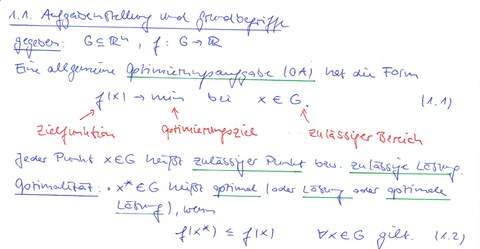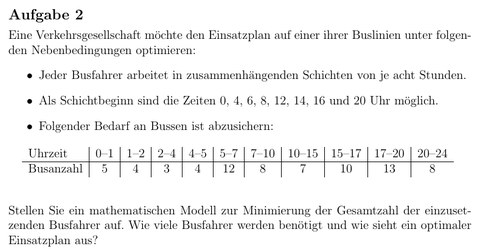Optimization – fundamental concepts: Dr. John Martinovic (#JM2)
Format
1. General:
- Elective compulsory course for different courses of study (mathematics, secondary school teaching, computer science) consisting of lectures, practicals and homework assignments
- Organization through OPAL course for timely and reliable provision of all important information and materials for the lecture and practical, including discussion forum for subject-related interaction with quick response times and detailed assistance.
2. Lecture:
- Asynchronous event
- Fully formulated digitized lecture notes
- Presentation and explanation of content using handwritten, blackboard-style notes in a total of 30 learning videos, each 15–25 minutes in length
- Clear fact sheets on the key lecture content in easily accessible “low-math” language
Simplex_procedure.pdf
3. Practical:
- Practical both on site (as long as this was possible) and online
- Provision of the practical exercises on an interactive website with assistance, intermediate or final results for comparison and step-by-step accompaniment of one’s own progress
https://optinum_ws2021.surge.sh/u3.html
https://optinum_ws2021.surge.sh/u4.html
- Detailed electronic sample solutions for each task
- Additional explanatory videos for solving the two to three most important or most difficult tasks of each sheet
4. Assignments:
- (Obligatory or voluntary, depending on the degree program) Completion of
smaller homework assignments in groups of two in order to establish and promote a professional exchange with other course members despite the online semester
- Prompt return of corrected submissions
Keywords
Mathematical optimization, elective, asynchronous course
Description
The course “Optimization – fundamental concepts” gives an insight into classical topics of mathematical optimization like modeling, theoretical foundations of continuous and discrete optimization as well as problem-specific numerical solution methods including their properties. It is formally placed in the fifth semester of the mathematics bachelor’s program and thus represents one of numerous modules in the elective compulsory area. In addition, this lecture is offered to students studying to become secondary school teachers (9th semester) and in the Diplom degree program in Computer Science (3rd semester) as a mathematics specialization. The auditorium is therefore typically very heterogeneous, not only with regard to the subject studied, but even more so with regard to individual study progress and level of knowledge. The greatest challenge in the professional design of this event is therefore to take into account the different expectations of the aforementioned groups in equal measure and to address them appropriately. This can succeed in particular if:
- The contents of the lectures are presented in a textbook-like manner and are thus self-contained and “self-evident” in the original sense of the word, i.e. they are written in such a way that they can be understood and can motivate.
- There is no focus on prepared slides, but the topics – not unlike the blackboard of a conventional lecture – are developed together at an appropriately moderate pace through handwritten notes, so that it is possible to write and think along at any time without restriction.
- Examples not only serve as a functional repetition of already learned theories, but at the same time also as a content-related link to the (still unknown) directly following topics and can thus be understood as a natural motor in the progression of a consistent trajectory.
- Lecture content and exercise sheets were designed in such a way that they served as an unerring compromise between classical calculation tasks, concrete application examples and (more difficult) theoretical derivations.
In the context of this course, I have tried as a lecturer to use the mission statement I have written for orientation, to do justice (as best I can) to the specific personal situations and needs of as many participants as possible despite constantly changing developments by means of the conceptual and content-related design of the module presented above, and to convey a maximum of transparency and reliability in otherwise uncertain times by means of clear communication of all upcoming decisions.
Contact
Dr. John Martinovic (#JM2)
Voting ID
#JM2


